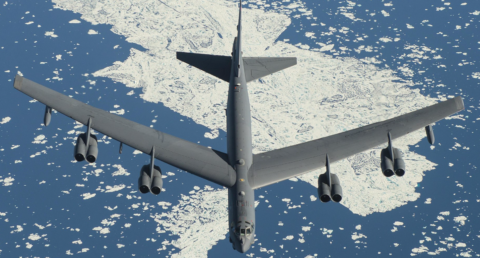Bret Devereaux wants to provide a basic idea of what we mean when we use the military term “strategic airpower”:

USAF B-52 Stratofortress near the North Pole on 31 July, 2016 during the Polar Roar exercise.
Detail of original USAF photo by Senior Airman Joshua King via Wikimedia Commons.
This week, I’m going to offer a fairly basic overview of the concept of strategic airpower, akin to our discussions of protracted war and nuclear deterrence. While the immediate impetus for this post has been Russian efforts to use airpower coercively in Ukraine, we’re going to focus more broadly on the topic: what is strategic airpower, where did the idea come from, how has it been used and does it actually work? As with nuclear deterrence, this is a much debated topic, so what I am going to present here is an overview of the sort I’d provide for an introductory class on the topic and then at the end we’ll cover some of the implications for the current conflict in Ukraine. That said, this is also an issue where I think most historians of the topic tend to part ways with both some things the public think they know about the topic and some of the things that occasionally the relevant branches of the military want to know about the topic; in any case I am going to try to present a fairly “down the middle” historian’s view of the question.
Before we dive in, we need to define what makes certain uses of airpower strategic because strategic airpower isn’t the only kind. The reason for the definition will emerge pretty quickly when we talk about origins, but let’s get it out of the way here: strategic airpower is the use of attack by air (read: bombing) to achieve “strategic effects”. Now that formal definition is a bit tautological, but it becomes clarifying when we talk about what we mean by strategic effects; these are effects that aim to alter enemy policy or win the war on their own.
Put another way, if you use aircraft to attack enemy units in support of a ground operation (like an invasion), that would be tactical airpower; the airpower is a tactic that aims to win a battle which is still primarily a ground (or naval) battle. We often call this kind of airpower “close air support” but not all tactical airpower is CAS. If you instead use airpower to shape ground operations – for instance by attacking infrastructure (like bridges or railroads) or by bombing enemy units to force them to stay put (often by forcing them to move only at night) – that’s operational airpower. The most common form of this kind of airpower is “interdiction” bombing, which aims to slow down enemy ground movements so that friendly units can out-maneuver them in larger-scale sweeping movements.
By contrast strategic airpower aims to produce effects at the strategic (that is, top-most) level on its own. Sometimes that is quite blunt: strategic airpower aims to win the war on its own without reference to ground forces, or at least advance the ball on winning a conflict or achieving a desired end-state (that is, the airpower may not be the only thing producing strategic effects). Of course strategic effects can go beyond “winning the war” – coercing or deterring another power are both strategic effects as well, forcing the enemy to redefine their strategy. That said, as we’ll see, this initially very expansive definition of strategic airpower really narrows quite quickly. Aircraft cannot generally hold ground, administer territory, build trust, establish institutions, or consolidate gains, so using airpower rapidly becomes a question of “what to bomb” because delivering firepower is what those aircraft can do.
As an aside, this sort of cabined definition of airpower and thus strategic airpower has always been frustrating to me. It is how airpower is often discussed, so it’s how I am going to discuss it, but of course aircraft can move more than bombs. Aircraft might move troops – that’s an operational use of airpower – but they can also move goods and supplies. Arguably the most successful example of strategic airpower use anywhere, ever is the Berlin Airlift, which was a pure airpower operation that comprehensively defeated a major Soviet strategic aim, and yet the U.S. Air Force is far more built around strategic bombing than it is around strategic humanitarian airlift (it does the latter, but the Army and the Navy, rather than the Air Force, tend to take the lead in long-distance humanitarian operations). Nevertheless that definition – excessively narrow, I would argue – is a clear product of the history of strategic airpower, so let’s start there.
And once again before we get started, a reminder that the conflict in Ukraine is not notional or theoretical but very real and is causing very real suffering, including displacing large numbers of Ukrainians as refugees, both within Ukraine and beyond its borders. If you want to help, consider donating to Ukrainian aid organizations like Razom for Ukraine or to the Ukrainian Red Cross. As we’re going to see here, airpower offers no quick solution for the War in Ukraine for either party, but the recent Russian shift to air attacks on civilian centers sadly promises more suffering and more pressing need for humanitarian assistance for Putin’s many victims.
Finally, a content warning: what we’re discussing today is largely (though not entirely) the application of airpower against civilian targets because it turns usually what “strategic” airpower ends up being. This is a discussion of the theory, which means it’s going to be pretty bloodless, but nevertheless this topic ought to be uncomfortable.
On with our topic, starting with the question of where the idea of strategic airpower comes from.



